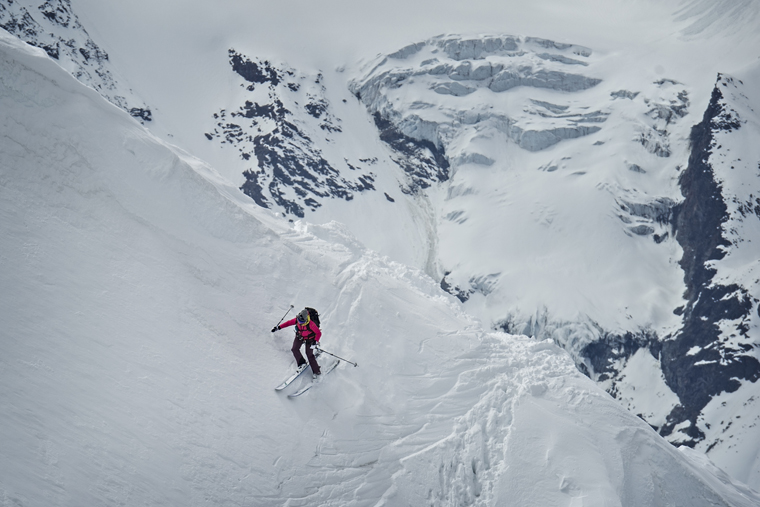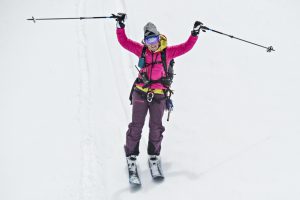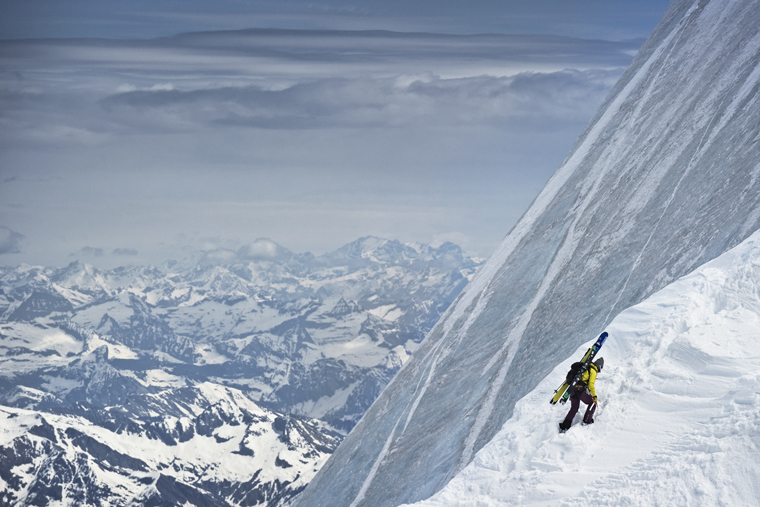15 minutes with Melissa Presslaber



ML: Two years ago on one of our home mountains, Venet, a small ski resort close to the Arlberg. It was January, 40cm of fresh fluffy powder, just one chairlift open, shredding with friends, awesome day!
Actually it’s just experience. As you do more and more, step by step these things open up for you. You get more into freeriding, then do a bit of climbing…
It’s no surprise as I’ve always calculated what I’m able to do, and what’s possible.
I would say it’s the combination of both. Having lift access is a great possibility, but the more memorable runs are those where you invest more time and take the effort to hike up for skiing down. All of the long hikes and adventures to the big mountains are still in my mind and not forgotten.
No, women can’t compare. The best girl is Giulia Monego, who’s been doing her IFMGA guide exams this summer. (She previously won the Verbier Xtreme and competed regularly on the Freeride World Tour.)
I wouldn’t say we were the pioneers, but we’re among the first who are climbing up and then just as focused on the down, with fat skis. There are very few women who are really good skiers and mountaineers. There are plenty of very good mountaineers. And plenty of very good skiers; but few combine the two.

Already the qualifying examination and the apprenticeship is very tough. For example
in Austria there are around 150 aspirants every year to take the qualifying examination, but only around 25 people are taken.
There is no exception to women. They have to go through the same qualifying procedure where you have to be an all-rounder in skiing, rock climbing and ice-climbing. Working as a mountain guide is tough. Also you have to be mentally and physically 100% fit, very flexible,
and if you want a family there are women-friendlier jobs.
It was actually filming As We Are that was the problem. I jumped a cliff, fell and tore my ACL. And I’d already had three surgeries before on that same knee (my right leg).
Luck is a big part in the world of freeriding. Injuries can happen very quickly, to anyone. And the main challenge is actually coming back. So to be on the Tour a long time you need luck and to be strong in the head. It’s definitely not about technique or fitness. Everyone at this level is an excellent skier and they all train really hard.
Shukran Morocco, whch I made with Sandra (Lahnsteiner, the pioneer of European all-girl ski movies who’s behind the Shades Of Winter series), was a very good time. We had fun and that was very well appreciated when it came out in 2012.
Mission Steeps, with Xavier de Le Rue, Andreas Fransson (and Samuel Anthamatten). When you get into all this steeps, and ski mountaineering, you need to see this. It’s very inspiring to see how they handle these situations!
Nothing really bad. It’s more when you travel a long way and conditions are not right. I’ve been to Mongolia, desperate to ski some north faces, and it was just ice. And rock. I’d definitely go back but that’s a long way to travel for no skiing.
[Laughs.] Oh yes, like no snow in the northern Alps last winter! There is no worst day of filming. The whole idea is to try always for the best, to get something, so you can’t really ever have a bad location.
Sometimes yes! It’s a lot less effort. But the other way I like to see it is if you’re a mountaineer, you get to know the face, and have time to see all the conditions. And make decisions based on this. Whereas in Alaska you’ve maybe just one or two minutes to scope the face before you drop it. It’s very different from a day’s hike, bivvy for the night, then climb up a north face.

The hardest I’d say is doing it all by myself. The north face of the Hochfeiler in the Zillertal I did solo. At points that’s 50°.
I knew I could do it, but still I was very happy to be back safe as plenty can go wrong when you have no support. When I was climbing up a group came skiing down and sluffed me in. I was trying to get out of the sluff zone but all this snow was hitting me, smashing me and my glasses. Luckily I had a good hold with my ice axes. I was so glad they held me.
I try to be aware of what can happen. But I never fear the mountain, it’s more respect. There’s never a time I’m really worried as I’m always focused. You are never 100% secure on any mountain. So prepare in the best way you can. But don’t fear it.